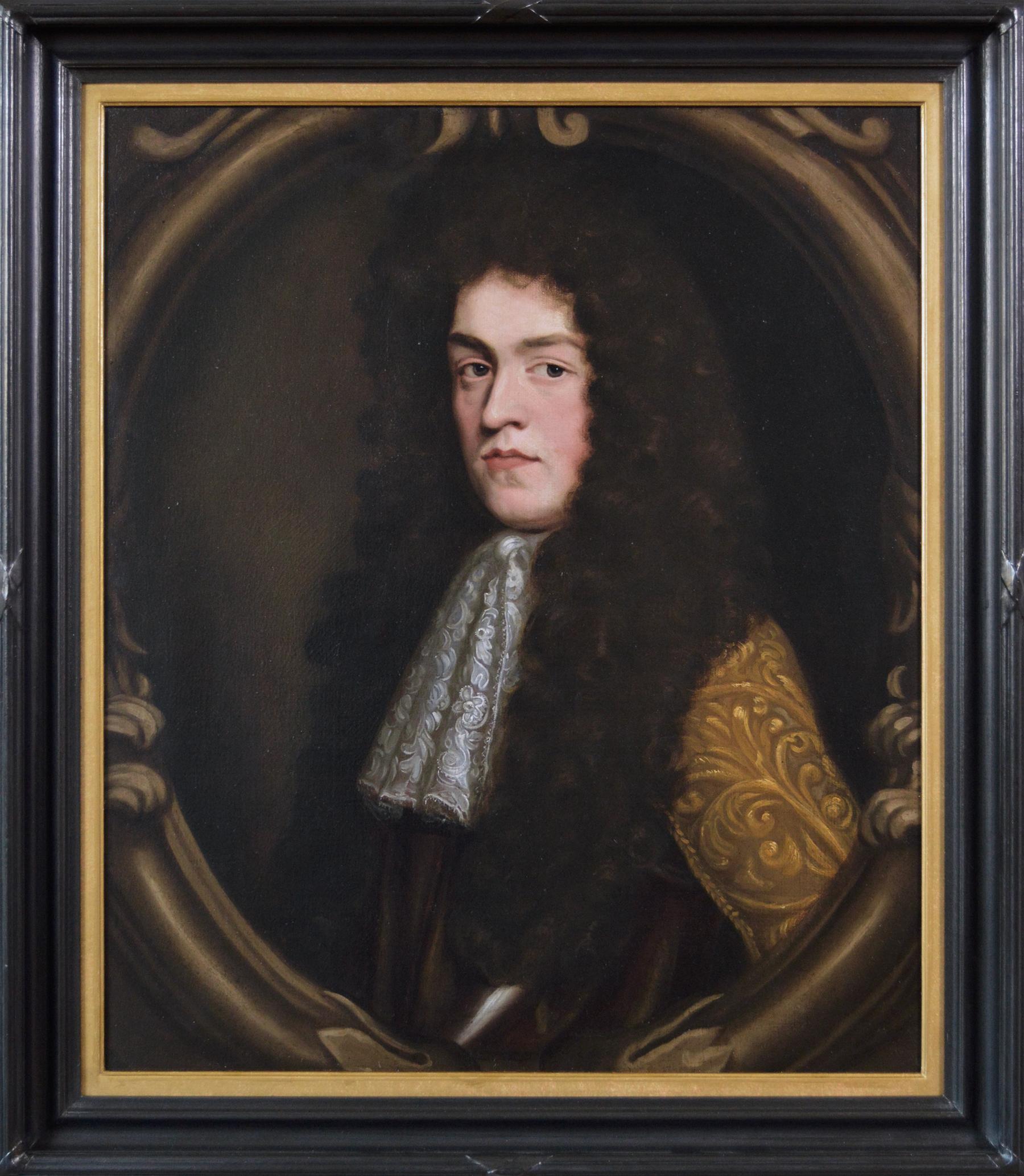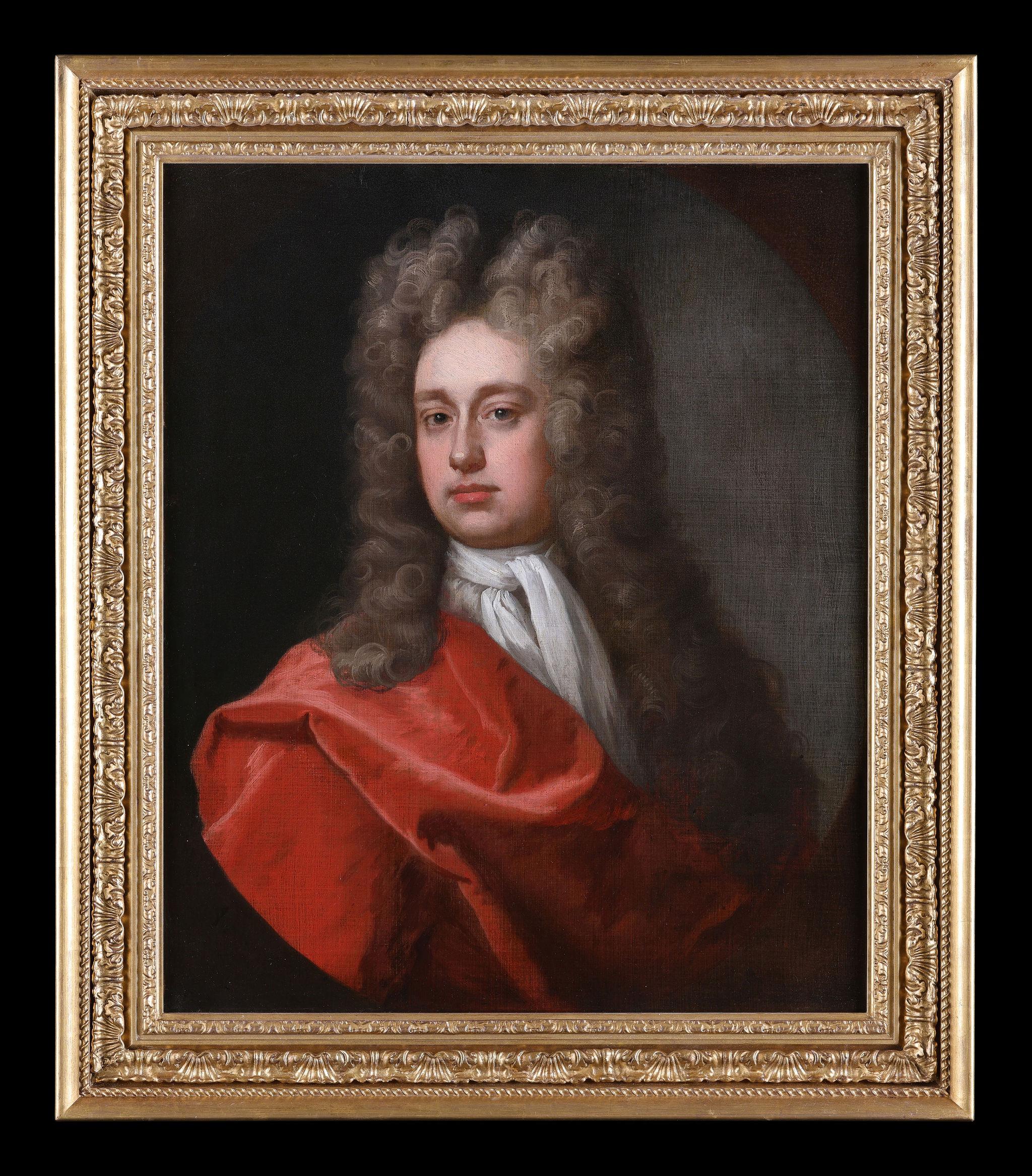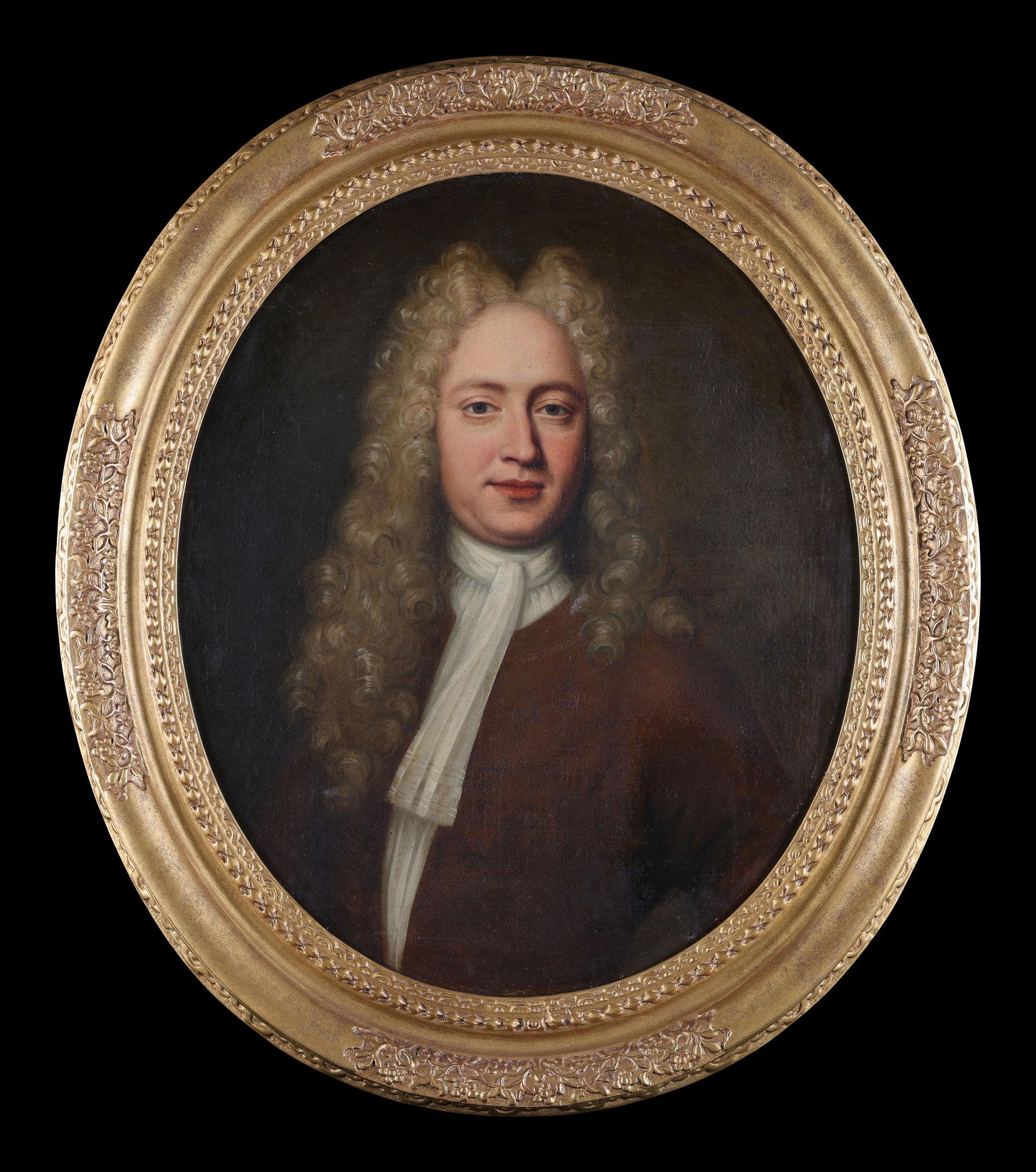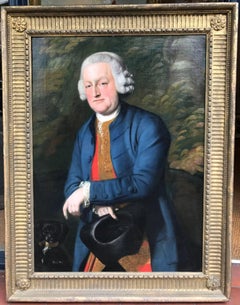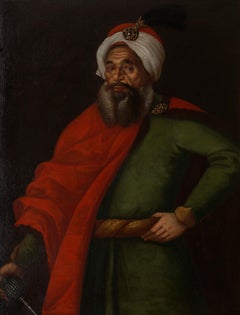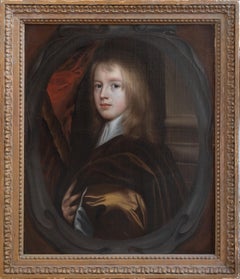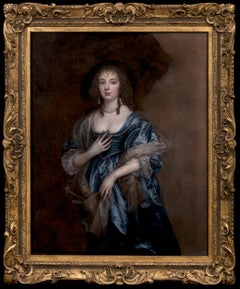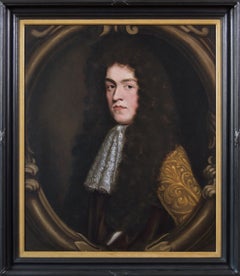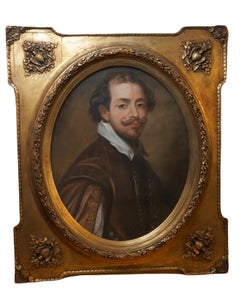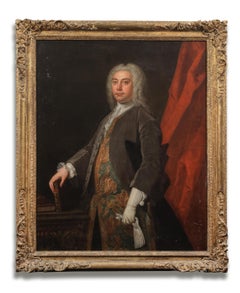Items Similar to A Portrait of a Gentleman, thought to be Moses Diego Lopez Pereira
Want more images or videos?
Request additional images or videos from the seller
1 of 5
UnknownA Portrait of a Gentleman, thought to be Moses Diego Lopez Pereira18th century
18th century
$19,177.26
£14,000
€16,498.12
CA$26,350.61
A$29,491.29
CHF 15,392.19
MX$359,641.67
NOK 196,999.02
SEK 186,484.80
DKK 123,123.27
Shipping
Retrieving quote...The 1stDibs Promise:
Authenticity Guarantee,
Money-Back Guarantee,
24-Hour Cancellation
About the Item
Austrian School, 18th Century
A Portrait of a Gentleman, thought to be Moses Diego Lopez Pereira, 1st Baron d’Aguilar, in an elaborate coat and a powdered wig
Oil on canvas
Provenance:
Ex Collection of Giorgio Forattini, Rome, Italy
Note: The cropped painting bears the following, indistinct but decipherable, inscription:
German: English:
[...JAMIN FREIHERR [...]JAMIN BARON
[G]EBO[REN]: 5te NOV:1699 BORN: 5th NOV. 1699
GEST[ORBEN]: 25 OCT 1759. DIED: 25 OCT 1759.
These dates correspond to the life of Moses Diego Lopez Pereira, 1st Baron d’Aguilar, a key figure among Sephardic Jews in 18th Century Vienna and London. He served as a Court Jew in Vienna, playing crucial roles and aiding the Habsburg Court in various capacities, including financial support for monumental constructions like Schönbrunn Palace. Originally from Portugal, his family, like many Sephardic Jews, left Spain to avoid expulsion due to their refusal to convert to Catholicism. He gained the favour of Empress Maria Theresa, becoming a Privy Councillor and playing a vital role in Jewish matters in Vienna.
Under Diego d’Aquilar’s initiative, a secret Sephardic Jewish community in Vienna received permission to have a synagogue. However, when the Spanish inquisition sought his extradition, he lost his Imperial protection, and the d’Aguilar family, who had returned to Judaism openly, had to flee to London. As a parting gesture, they gifted magnificent silver crown pieces to Viennese Turkish Jews for their Torah scrolls, engraved with the d’Aquilar name. His memory is commemorated annually on Yom Kippur.
The significance of the name “...jamin” is unclear, but it might be related to the Tribe of Benjamin, one of the 12 tribes of Israel, to which d’Aguilar belonged.
Dimensions:
(Panel) 31 in. (H) x 22.75 in. (W)
- Creation Year:18th century
- Dimensions:Height: 31 in (78.74 cm)Width: 22.75 in (57.79 cm)
- Medium:
- Period:
- Condition:Condition report available upon request.
- Gallery Location:London, GB
- Reference Number:1stDibs: LU673314327742
About the Seller
5.0
Vetted Professional Seller
Every seller passes strict standards for authenticity and reliability
Established in 1990
1stDibs seller since 2017
42 sales on 1stDibs
- ShippingRetrieving quote...Shipping from: London, United Kingdom
- Return Policy
Authenticity Guarantee
In the unlikely event there’s an issue with an item’s authenticity, contact us within 1 year for a full refund. DetailsMoney-Back Guarantee
If your item is not as described, is damaged in transit, or does not arrive, contact us within 7 days for a full refund. Details24-Hour Cancellation
You have a 24-hour grace period in which to reconsider your purchase, with no questions asked.Vetted Professional Sellers
Our world-class sellers must adhere to strict standards for service and quality, maintaining the integrity of our listings.Price-Match Guarantee
If you find that a seller listed the same item for a lower price elsewhere, we’ll match it.Trusted Global Delivery
Our best-in-class carrier network provides specialized shipping options worldwide, including custom delivery.More From This Seller
View All18th Century Oil Painting Portrait of Phillip, 6th Viscount Wenman.
By Nathaniel Dance-Holland
Located in London, GB
Sir Nathaniel Dance-Holland (1750-1811) was an English portrait painter and one of the founding members of the Royal Academy in 1768. Justly celebrated in his lifetime he won several...
Category
Late 18th Century Old Masters Portrait Paintings
Materials
Oil
Portrait of Ochius, also called The Passia Ahmed ex Royal Collection of Hanover
By (Attributed to) Sir Godfrey Kneller
Located in London, GB
Attributed to Sir Godfrey Kneller (1646 - 1723)
A Portrait of Ochius, also called The Passia Ahmed
Oil on canvas
In a gilded frame
Painted circa 1689 following the siege of Belgrad...
Category
17th Century Portrait Paintings
Materials
Oil
17th Century Oil Painting Portrait of a Young English Boy
By Gerard Soest
Located in London, GB
Gerard SOEST (1600 - 1681)
Portrait of a Young Boy
oil on canvas
35.5 x 30.5 inches inc. frame
Gerard Soest (circa 1600 – 11 February 1681), also known as Gerald Soest, was a portra...
Category
17th Century Old Masters Portrait Paintings
Materials
Oil
Portrait of Anne, Lady Russell, later Countess of Bedford
By Anthony van Dyck
Located in London, GB
A three-quarter length portrait of Anne, Lady Russell, later Countess of Bedford (1615-1684), in a blue dress. Attributed to Sir Anthony Van Dyck.
Anne C...
Category
17th Century Portrait Paintings
Materials
Oil
Portrait of an Italian Noblewoman
Located in London, GB
15th century, Italian
Circle of Antonio del Pollaiuolo (1429-1498)
Portrait of an Italian Noblewoman
Oil and tempura on poplar panel
With partial inscription: ALZETAPIN
Provenance:...
Category
15th Century and Earlier Renaissance Portrait Paintings
Materials
Oil, Tempera, Wood Panel
16th Century Italian Renaissance Old Master Portrait of a Procuratore
By Jacopo Bassano
Located in London, GB
Jacopo BASSANO (c. 1510-1592, Italian)
Portrait of a Procuratore
Oil on canvas
30 ¼ x 26 inches (including frame)
Provenance: Lucien Bonaparte’s Collection (as Portrait of Doge Priuli, Tiziano); Rich-mond, Virginia Museum, Portrait of Doge Lorenzo Priuli.
The painting is a portrait of a man half-length, on a black background. It is a three-quarter portrait, according to a custom very common in the genre of portraiture in sixteenth century. The man is wearing a decorated...
Category
16th Century Old Masters Portrait Paintings
Materials
Oil
You May Also Like
17th Century portrait oil painting of a gentleman
By Willem Wissing
Located in Nr Broadway, Worcestershire
Circle of Willem Wissing
Dutch, (1656-1687)
Portrait of a Gentleman
Oil on canvas
Image size: 29 inches x 24.5 inches
Size including frame: 35 inches x...
Category
17th Century Portrait Paintings
Materials
Canvas, Oil
Portrait of a well-to-do gentleman
Located in DEVENTER, NL
Portrait of a well-to-do gentleman in pastel on parchment.
Signed left: Marteau L. 1760.
French School, possibly by Louis Marteau (1715 – 1804)
In a gilded 19th century frame.
Dimen...
Category
18th Century Portrait Paintings
Materials
Parchment Paper, Pastel
large 18th century portrait gentleman oil on canvas
Located in York, GB
A fine, imposing 18th century portrait of an unknown aristocrat,housed in a gilt frame
The artist is also unidentified but certainly a talented hand, in the circle of one of the fine old masters of the period
The size overall is 148 x 121 cm whilst the painting is 128 x 101 cm
In overall good condition the frame at the bottom has bowed slightly
The painting has been checked whilst being cleaned and has not been affected in any way .
SHIPPING
Free delivery to mainland uk ,worldwide shipping available please email for quote
Delivery usually within 14 working days, insured
please provide telephone/email details for courier.
All taxes/customs etc to be paid for by purchaser.
RETURNS (The Consumer Contracts Regulations) Whilst we are sure that you will be extremely happy with your purchase,
if for any reason you are not, then you are entitled to return the item to us for a refund.
For all purchases made
you are entitled to return the item(s) for a period of up to 14 days
following receipt by you or a representative indicated by you.
Please contact us to confirm that you are returning the item(s)
and the reason for doing so.
Upon receipt of the item(s) we will refund the purchase price via your original payment method...
Category
18th Century Old Masters Portrait Paintings
Materials
Oil
$7,533 Sale Price
44% Off
Free Shipping
Portrait of Ralph William Grey
By Bartholomew Dandridge
Located in London, GB
Provenance
By descent through the sitter's family to
The Collection of R. W. Vivian-Neal of Poundisford Park, Somerset, from whom acquired by
With Lane Fine Art, UK, where purchased by the present owners in 1996
Literature
'Poundisford Park, Somerset' in Country Life, 22 December 1934, ill.
A.W. and C.M. Vivian-Neal, Poundisford Park, Somerset: A catalogue of pictures and furniture, Taunton 1939, cat. nos. 11 and 13
This is a three-quarter-length portrait of Ralph William Grey in a mole-coloured velvet coat and a long waistcoat of green satin, heavily embroidered in gold. Under his left right hand is a black chapeau bras. He has white doe-skin gauntlet gloves.
Son of William and Ann Grey of Backworth: born 19 December 1707. He married Mary the daughter of William Rawstorne of Newall in 1741 and died 5 November 1786. He was educated at Eaton and Trinity College, Oxford.
Within a year of his birth Mrs Grey died and, according to the Country Life article 'From that time forward all Mr Grey's faculties were concentrated on the well-being of his son. The possession of an heir gave zest to his efforts to build up the family fortune: he was successful in most of his ventures. Years later his interest in life was centred in the home of his daughter-in-law and grandchildren'.
Grey's right hand is depicted in the present portrait resting on Locke's Essays and the Country Life article also records that there are constant references to John Locke...
Category
Mid-18th Century English School Portrait Paintings
Materials
Oil
A Bewigged Gentleman
By Enoch Seeman
Located in St. Albans, GB
Enoch Seeman
Oil on Canvas
Canvas Size: 30 x 25" (76 x 64cm)
Outside Framed Size: 37 x 32" (94 x 82cm)
He was born in Danzig, now Gdansk, Poland, around 1694. His father, also En...
Category
Late 18th Century English School Portrait Paintings
Materials
Oil
A Portrait of a Bewigged Gentleman
By Enoch Seeman
Located in St. Albans, GB
Enoch Seeman
Canvas Size: 30 x 25" (76 x 62cm)
Outside Frame Size: 37 x 32" (92 x 80cm)
1694-1744
He was born in Danzig, now Gdansk, Poland, around 1694. His father, also Enoch...
Category
Early 18th Century Old Masters Portrait Paintings
Materials
Oil
More Ways To Browse
Jew Painting
Portrait Of A Gentleman
Imperial Portrait
Antique Jewish Art
Spanish Jewish
Synagogue Painting
Vienna 18th
Jewish Synagogue
18th Century Family Portrait
English Gentleman Painting
Torah Art
18th Century German Portraits
Portrait German 18th Century
Jewish Torah
Empress Portrait
18th Portrait Gentleman
18th Century Portrait Of Gentleman
18th Century Portrait Of A Gentleman
